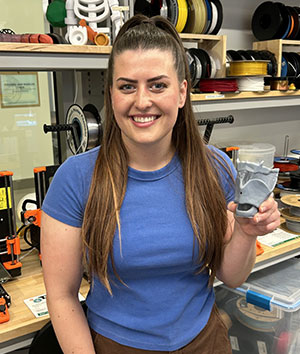
Contact Us
Institutional Communications
Bureau of Mines Building, Room 137
Laramie, WY 82071
Phone: (307) 766-2929
Email: cbaldwin@uwyo.edu
UW Communication Disorders Graduate Student Creates 3D Human Larynx Model
Published June 05, 2024

Kimberly Quincy, a first-year graduate student in UW’s Division of Communication
Disorders, displays a 3D human larynx model she created using an online software program
as part of the Make-IT Makerspace in UW’s Information Technology Center. (Hannah Young
Photo)
A University of Wyoming graduate student in the Division of Communication Disorders has used innovative technology to create a three-dimensional physical model of a human larynx to aid in the study of vocal anatomy and physiology.
Kimberly Quincy, a first-year graduate student from Willow, Alaska, used Tinkercad, an online software program, to conceptualize and craft the manipulable 3D human larynx. She recently was featured as a presenter at UW’s PokeBot V6.02, an interdisciplinary event sponsored by the Make-IT Makerspace in the UW Information Technology Center that showcases creative and innovative students doing “the unexpected with technology.”
The larynx, commonly referred to as a person’s voice box, is located in the neck and performs several important functions. This organ is involved in breathing, swallowing and the ability to talk and make sounds. When the larynx isn’t working properly or has been injured, this can greatly impact quality of life. Such disorders are a focus of research conducted by UW’s Division of Communication Disorders, part of the College of Health Sciences.
Quincy’s advanced model demonstrates the dynamic movement of vocal folds in response to the manipulation of other structures within the larynx. By seeing a tangible representation of this movement, students learning about voice disorders can gain a clear visualization of the mechanisms at play and actively engage in manipulating vocal pitch, thereby enhancing their understanding of the physiological process.
“Initially, I greatly lacked knowledge in the 3D world. However, every hurdle I faced throughout this project became an opportunity for learning,” Quincy says. “Ultimately, this project enriched my understanding of human anatomy and the mechanics of vocal fold movement.”
Quincy’s faculty mentor, Assistant Professor Zoe Kriegel, plans to develop an open educational resource based on this newly conceptualized model to benefit future students studying vocal anatomy and physiology.
Kriegel’s research investigates the effects of competing demands on speech for people with and without Parkinson’s disease. Her work uses challenging speaking contexts, including dual-tasking, mental manipulation and cognitive-linguistic interference, to examine changes in speech production during complex tasks. Ongoing work aims to characterize speech acoustics, kinematics and facial muscle activity patterns for people with and without Parkinson’s disease to inform clinical assessment and treatment decisions. Additionally, she teaches graduate students in the areas of motor speech and voice disorders.
“It can be challenging for graduate students to understand the relationships between the moving parts in the larynx,” Kriegel says. “Kimberly’s work has created the first 3D printed, movable laryngeal model to support instruction on pitch control with the voice. In the future, this model will be developed into an open educational resource so that anyone can freely access and print this model to use it in their own classrooms.”
Professor Mark Guiberson, director of the Division of Communication Disorders, expresses a similar view on the innovations in education provided to students in the division -- and the positive outcomes for clients they will interact with.
“Kimberly’s 3D larynx model is an example of the innovative teaching and learning that we strive for in the Division of Communication Disorders,” Guiberson says. “This project exemplifies the spirit of creativity in approaching our work with individuals with communication and other challenges. It’s also just cool.”
Learn more about the Division of Communication Disorders by visiting www.uwyo.edu/comdis/index.html.
About the University of Wyoming College of Health Sciences
UW’s College of Health Sciences trains health and wellness professionals and researchers in a wide variety of disciplines, including medicine, nursing, pharmacy, speech-language pathology, social work, kinesiology, public health, health administration and disability studies. The college also oversees residency and fellowship programs in Casper and Cheyenne, as well as operating a speech/hearing clinic in Laramie and primary care clinics in Laramie, Casper and Cheyenne.
With more than 1,600 undergraduate, graduate and professional students, the college is dedicated to training the health and wellness workforce of Wyoming and conducting high-quality research and community engagement, with a particular focus on rural and frontier populations.
Contact Us
Institutional Communications
Bureau of Mines Building, Room 137
Laramie, WY 82071
Phone: (307) 766-2929
Email: cbaldwin@uwyo.edu
